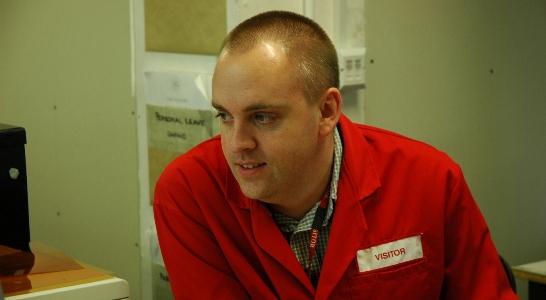20 June 2011
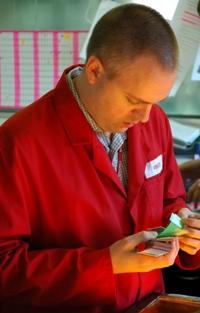
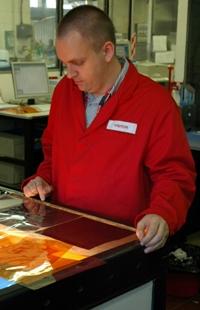
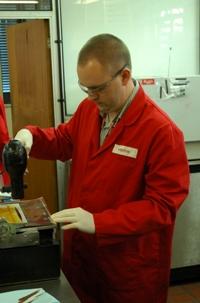
Photos and story with thanks to LEE Filters
Lighting designer Declan Randall has a wide grin on his face. Clad in a fetching red lab coat, he walks briskly and with intent from the lightbox, over to a custom-built, enclosed room that’s fondly referred to as the ‘igloo’. Inside, the smile fades a little, replaced by a frown of concentration.
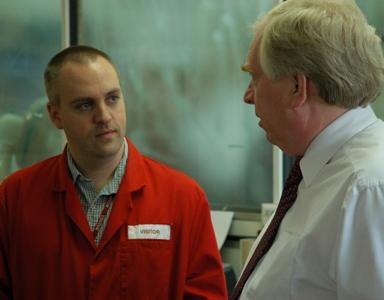 A moment later, he’s back at the lightbox and what’s fast becoming a ritual is repeated. Eventually, he pauses, but only to chuckle, “I’m like a kid in a sweet shop.”
A moment later, he’s back at the lightbox and what’s fast becoming a ritual is repeated. Eventually, he pauses, but only to chuckle, “I’m like a kid in a sweet shop.”
South Africa born Declan is spending the day in the R&D section of LEE Filters.
The aim? To create a new colour for the catalogue – one that celebrates 50 years of the Association of Lighting Designers. For Declan, the choice of colour is obvious: it’s got to be gold.
With lighting designs that span genres and nations (from High School Musical to Porgy and Bess, from Hong Kong to New York City), Declan’s experience is nothing if not varied. A self-confessed lighting obsessive, he is fascinated by what he refers to as the ‘texture’ of light – the form it takes and how our eyes translate it in our everyday surroundings. Fortunately, he is also open to experimentation, because it turns out that creating the gold that – at the beginning of the day’s activities – exists only in his mind’s eye, is trickier than it would first appear.
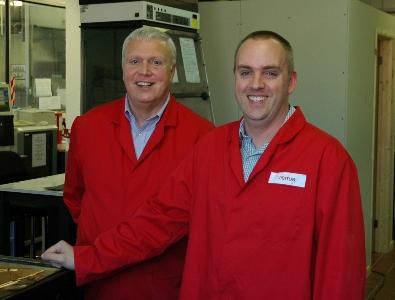 It would be easy to assume the gold that Declan is visualising is a rich, deep hue with the qualities of molten metal but, in fact, what he’s after is altogether more subtle. “Imagine the reflection off a bar of gold,” he says, holding the palm of his hand above a sheet of gel that’s laid on the lightbox. “That reflected colour is what I’m trying to achieve. And, of course, gold has a kind of shimmer to it, so we have to try to create something that captures that quality. It not only has to look gold, it has to react to light in the way that gold would.”
It would be easy to assume the gold that Declan is visualising is a rich, deep hue with the qualities of molten metal but, in fact, what he’s after is altogether more subtle. “Imagine the reflection off a bar of gold,” he says, holding the palm of his hand above a sheet of gel that’s laid on the lightbox. “That reflected colour is what I’m trying to achieve. And, of course, gold has a kind of shimmer to it, so we have to try to create something that captures that quality. It not only has to look gold, it has to react to light in the way that gold would.” 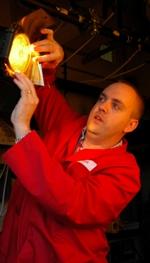
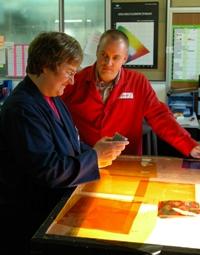
While his projects include architectural and exhibition work, Declan visualises the gold he is hoping to create as existing more in the context of the theatre. But before it reaches that point, it is the job of Alison Chetwynd, head of R&D at LEE Filters, and with twenty four years of experience under her belt, to translate Declan’s vision and description into reality. She has prepared a number of test sheets as a starting point, based on previous discussions with Declan. In the past, in order to achieve the sort of gold he sees in his mind’s eye, he has combined filters to create what he describes as a “greeny-black yellow”. This is the first combination that’s created. It’s close, but not quite what he hopes for.
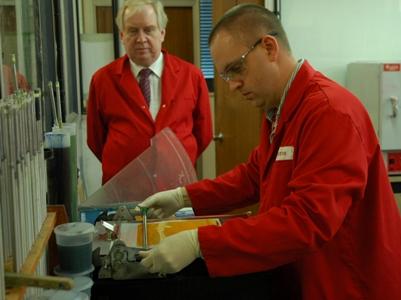 It’s complicated, this business. Having decided that there’s a pinkiness missing from the tests, the next attempt goes too much the other way. It’s clear there could be almost infinite subtle variations – all of which could, in some way, be labelled as gold, but Declan’s ‘reflected’ gold is proving elusive. “We’ll know when it’s right,” he says. “And equally, we’ll know when it isn’t.”
It’s complicated, this business. Having decided that there’s a pinkiness missing from the tests, the next attempt goes too much the other way. It’s clear there could be almost infinite subtle variations – all of which could, in some way, be labelled as gold, but Declan’s ‘reflected’ gold is proving elusive. “We’ll know when it’s right,” he says. “And equally, we’ll know when it isn’t.” 
During a break for lunch, Alison is spotted studying her wedding ring, turning her hand this way and that to understand the way in which light reflects from it. This must have done the trick, because shortly after our return to the lab, there is the long-awaited eureka moment. Having run the gamut of golds that were too acidic, not warm enough and too heavy on the green, the tone that Declan had in mind was achieved. “I knew something was missing – I just didn’t know what,” he says. “We were almost there with one of the tests, which was just right at the lower range of the lamp’s intensity. I wanted it to do the same thing, but at higher intensities.”
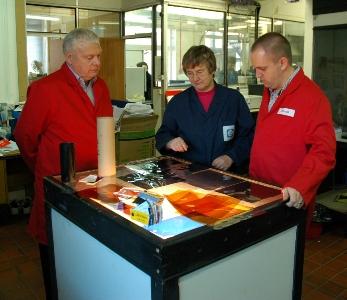 So how did they do it? Simple. By adding a warm up filter to a previous test formula. This reduced the overly yellow appearance of the previous test, and introduced what was definitely a ‘proper’ gold, that remained such even when tested under a variety of sources and in a range of intensities. “It maintains its richness as it dims,” explains Declan, “becoming more molten as the percentage is reduced. You could see it being used for anything from early morning sunlight to a kind of surreal candlelight.”
So how did they do it? Simple. By adding a warm up filter to a previous test formula. This reduced the overly yellow appearance of the previous test, and introduced what was definitely a ‘proper’ gold, that remained such even when tested under a variety of sources and in a range of intensities. “It maintains its richness as it dims,” explains Declan, “becoming more molten as the percentage is reduced. You could see it being used for anything from early morning sunlight to a kind of surreal candlelight.” 
In its simplest form, the end result is a layer of carefully selected dyes in lacquer form, poured onto a sheet of polyester and spread evenly. But it’s so much more than that: it’s sunrise and sunset; it’s a wash of colour over a desert; it’s a subtle backdrop. The result is 550 ALD Gold. It’s alchemy.
